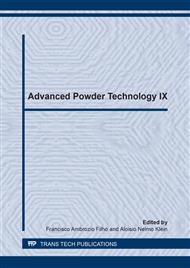p.220
p.226
p.232
p.239
p.245
p.250
p.256
p.262
p.268
Analysis of the Effect of the Underflow Orifice Size on the Filtering and Concentrating Hydrocyclone
Abstract:
Hydrocyclones are equipments widely used in solid-liquid separation, as in mineral, chemical, petrochemical, textile, and metallurgical industries. The suitable choice of its dimensions depends on the process main objective. There is the case that the major interest is to concentrate a suspension, either to discard the dispersed phase (solids) or to use it. The objective of this work was to study, experimentally, a filtering hydrocyclone with a suitable geometry that provides a low underflow-to-throughput ratio, i.e., that produces a thick underflow. The effect of the underflow orifice diameter in the equipment performance was evaluated. The results showed that the smallest orifice size produced an underflow stream with concentration upper than 45% in volume.
Info:
Periodical:
Pages:
245-249
Citation:
Online since:
December 2014
Price:
Сopyright:
© 2014 Trans Tech Publications Ltd. All Rights Reserved
Share:
Citation:


